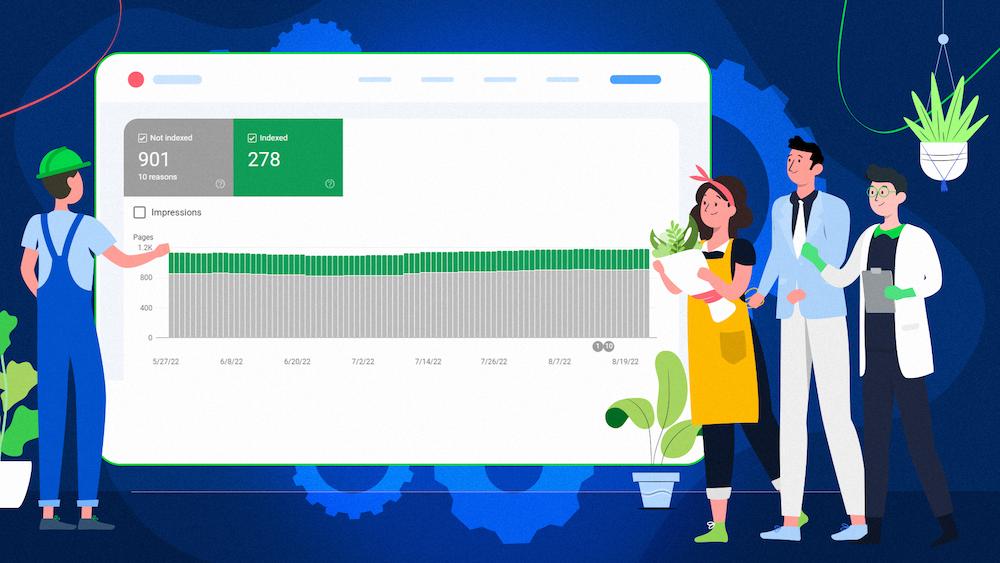What is KEYWORD RESEARCH? The main goal of Keyword Research (KR) is to expand your knowledge about the keywords you can rank for and target your pages with. By performing keyword research, you can also learn more about your customers overall. You can get to know your niche better and follow the most popular queries in it, so you can create quality content that will meet your potential customer’s expectations.
Beware what you type into a search box.
Ranking for the right keywords is the main factor that brings more users to your site. But how can you know which keywords are right for your website? The answer is simple – Keyword Research!

This article is not meant to be an ultimate guide on “how to do perfect keyword research” because every SEO that performs KR does it their own way. The following article describes my personal way of thinking during the creation of keyword research.
But before we dive in, we need to start with some dry theory.
The Value of Keywords
Keyword value is one of the things you need to consider when doing keyword research, and you can do this from two perspectives — objective and subjective.
The objective value of a keyword refers to the general parameters provided by various tools. There are many parameters that describe the objective value of a keyword, but the two most important are:
- Search Volume — this is the keyword’s popularity; how often users search for it.
- Keyword Difficulty — this is how hard it will be to achieve high positions for this particular keyword.

The subjective value of a keyword tells you how much it might be worth to your site and your business profile. To figure this out, you need to answer some questions first.
Does this keyword fit your site?
Will users be satisfied when they get to your site looking for this phrase?
Will the traffic created by this keyword be financially beneficial?
If you answered YES to all those questions, then using this keyword might turn out to be profitable, and you can try to optimize your site around it.
Types of Keywords
Not all keywords are created equally. Depending on how often users search for them, they can be divided into two main groups: head and long-tail keywords.
Head Keywords
The most common search terms are called head keywords. While these keywords may be popular, most of these queries are very general; thus making it much harder to achieve high positions in the search results for them.
Long-Tail Keywords
The second group of search terms is long-tail keywords. These are more specific and usually longer than head keywords and should be the main part of a keyword research strategy. They are not as popular as head keywords, but they take up 70% of all internet searches and most of the overall search volume if we put them all together.
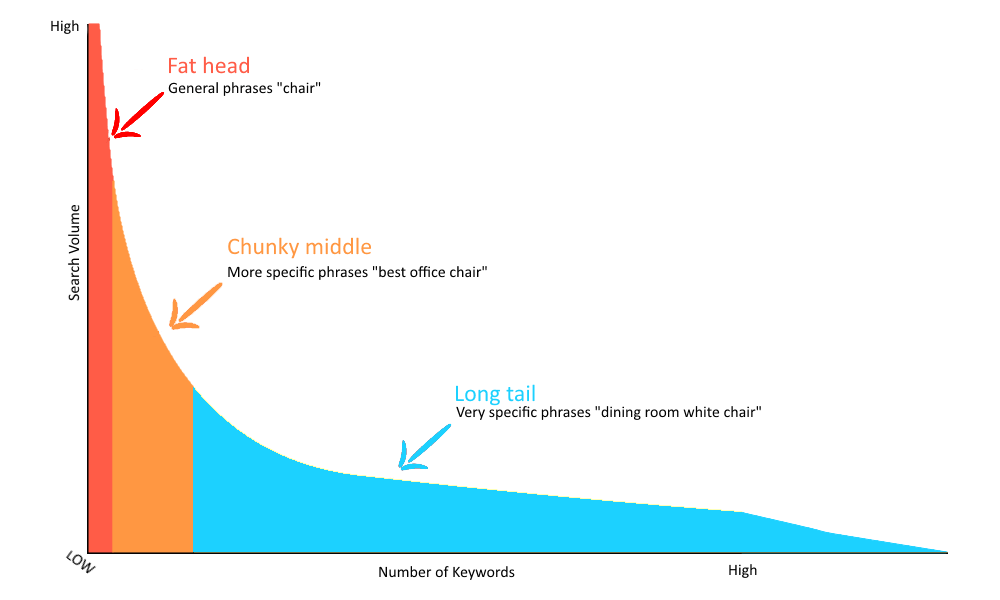
And unlike head keywords, marketers have noticed that long-tail phrases convert to profit because of the focus on a specific product or a phrase.
For example, users searching for “chair” are probably just browsing. However, someone searching for “white dining room chair” is probably also browsing, but with their wallet already open.
Keywords Categorized by Purpose
Another way to divide keywords is based on their purpose. We can divide them into four groups:
- Commercial keywords
- Transactional keywords
- Informational keywords
- Navigational keywords
1. COMMERCIAL
This group of keywords is the widest of the four and is directly connected to your niche.
You want to use as many of the most popular and commercial-worthy keywords as you can, but it is more important to remember that you want to stick to keywords that are directly connected to your niche.
For example, if you own a website that only sells chairs, you don’t want to rank for tables because they have four legs too — they’re not chairs, so screw ’em!
The goal of these keywords is to bring more users to your site. But you need to realize that the user status is not enough — you want customers. This is why we have the next group of keywords.
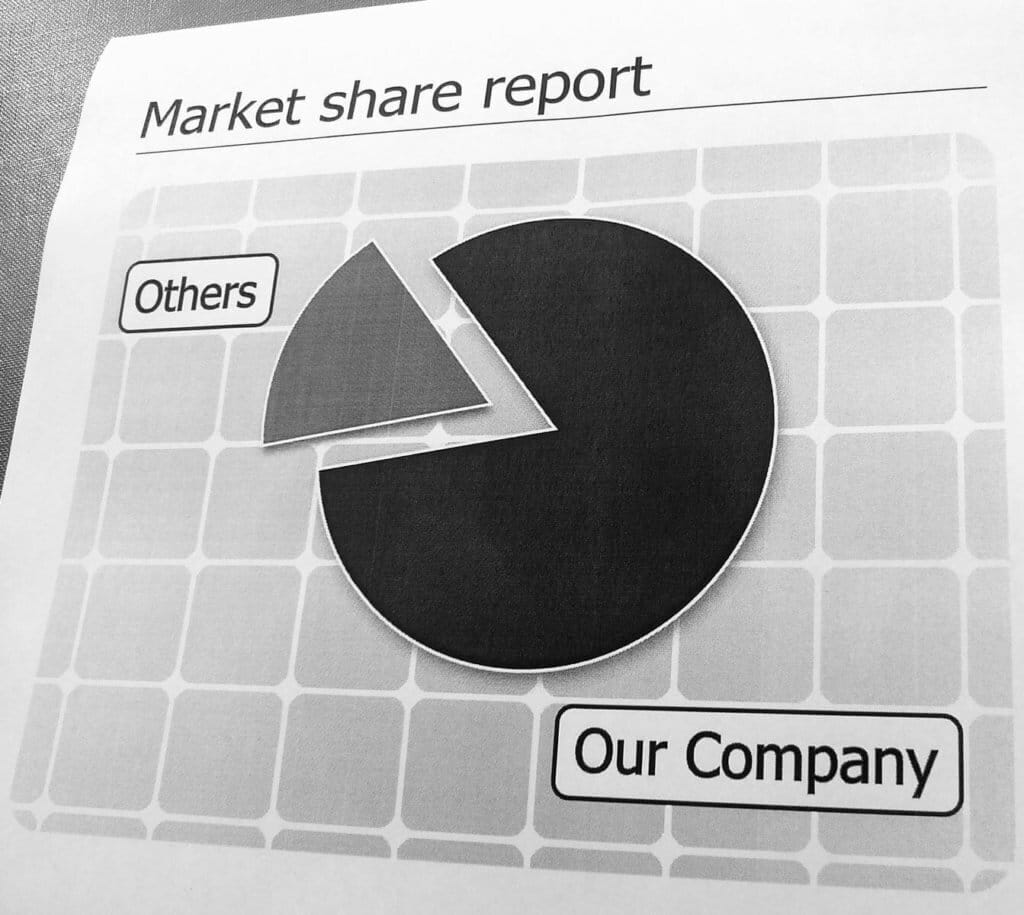
2. TRANSACTIONAL
Such keywords are perfect for pages like product listings because they use terms like “buy,” “for sale,” “purchase,” and so on.
In this group, you can also find more specific phrases like “black leather chair.” When users search for these phrases, you can say that they already have all the information they need — they know what they want and are determined to make a purchase.
But what if they are still looking for some information before buying your product?
3. INFORMATIONAL
You can find a lot of keywords with great search volume, but they might not bring your site many conversions. This is because when users are searching for these phrases, they are often searching for information, e.g., to make sure that they want to buy this particular product — read reviews or compare it with other products.
These phrases are often in the form of a question. As I said, informational keywords might not bring you the most conversions, but why not use the most popular ones for blog articles, which will help the overall visibility of your site and brand?

4. NAVIGATIONAL
The name might sound confusing, but this one is the simplest of them all. This type of keyword refers directly to your brand. That’s it.
When users type your brand’s name into the search bar, this means they are familiar with it, and they’re performing a navigational search to get to the right address.
If you have a strong brand, it’s fundamental to rank your homepage for phrases connected to it. But if you just started building your presence on the market, don’t try to rank for your competitor’s brand — you won’t beat them that way.
But you can beat your competitors with proper keyword research, and that’s what I’ll present to you right now with a tool called Ahrefs.
Ahrefs
Ahrefs is a very powerful paid tool that’s worth the price. It’s mainly known as a “backlink checker,” but we are going to use its other functions, particularly two features related to keyword research.

First of all, it’s worth mentioning where Ahrefs is taking the data from. The smart people at Ahrefs created their own crawling bot that allows them to collect data from the web. Because their bot is super efficient, second to Googlebot (according to a study about the best active bots), Ahrefs possesses one of the most impressive databases of keywords, domains, URLs, links, and so on. You can find their database’s stats on their site.
Another aspect I want to present is the keyword metrics provided by Ahrefs.

The two main metrics that I mentioned in The Value of Keywords section are present here – Search Volume and Keyword Difficulty.
Search Volume in Ahrefs refers to how many searches a particular keyword has in a month. This factor also depends on the seasonality of a particular keyword. For example, phrases like “Christmas Gifts” are more popular closer to Christmas and have a larger Search Volume during that time. It’s worth noting that Ahrefs’s Keyword Difficulty is not linear, so if the scale goes from 0-100 – the number 50 doesn’t refer to the medium difficulty of a keyword – “hard” keywords start with around a 30 keyword difficulty. You can find more info about Keyword Difficulty on Ahrefs’s blog.
There are other keyword metrics provided by Ahrefs:
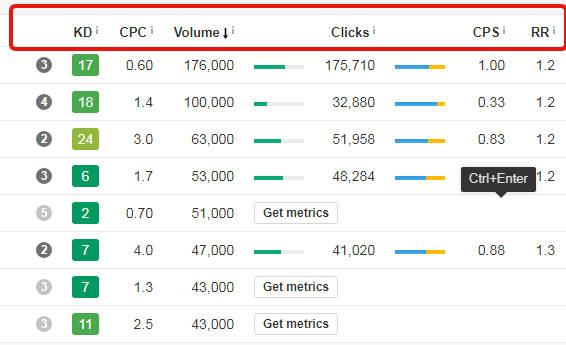
- CPC (Cost per Click) – I won’t be focusing on this one as it’s used for paid advertisements and not organic searches.
- Clicks – this refers to the overall monthly number of clicks in the search results performed by users after typing a particular query in a search box.
- CPS (Clicks per Search) – this shows how many different search results users click on average while searching for this keyword.
- RR (Return Rate) – is a relative value that shows how often users search for this keyword again.
There are more options to present in Ahrefs, but I think it will be better to show them with the keyword research example below. I’ll be using “chair” with furniture store as the niche.
Competitor analysis
The first step in finding beneficial keywords is to identify the direct competitors for your site in order to see which keywords they are ranking for because it’s possible that they already did the lion’s share of keyword research for you.
By direct competitors, I mean competitors with a business profile the same as yours. If a site is huge and its business profile is wider than yours, this means their keyword directory is also huge and diverse, AND it means they’re not your direct competitor. There is no point in competing with them. You want to compete with sites that are present in the same market as you that you can realistically beat. When you choose proper direct competitors, you can use the majority of their keyword directories to expand yours.

So let’s do that!
Go to Ahrefs’ site explorer and let’s find a direct competitor for our furniture store. One option for doing this is to Google one of the obvious main phrases connected to your niche like “furniture store USA” and look at the top results, or if your site is already ranking, for some keywords. You can find your main competitors in Ahrefs’ Overview of your site in the Organic search tab, which are chosen by the number of shared keywords with your site.
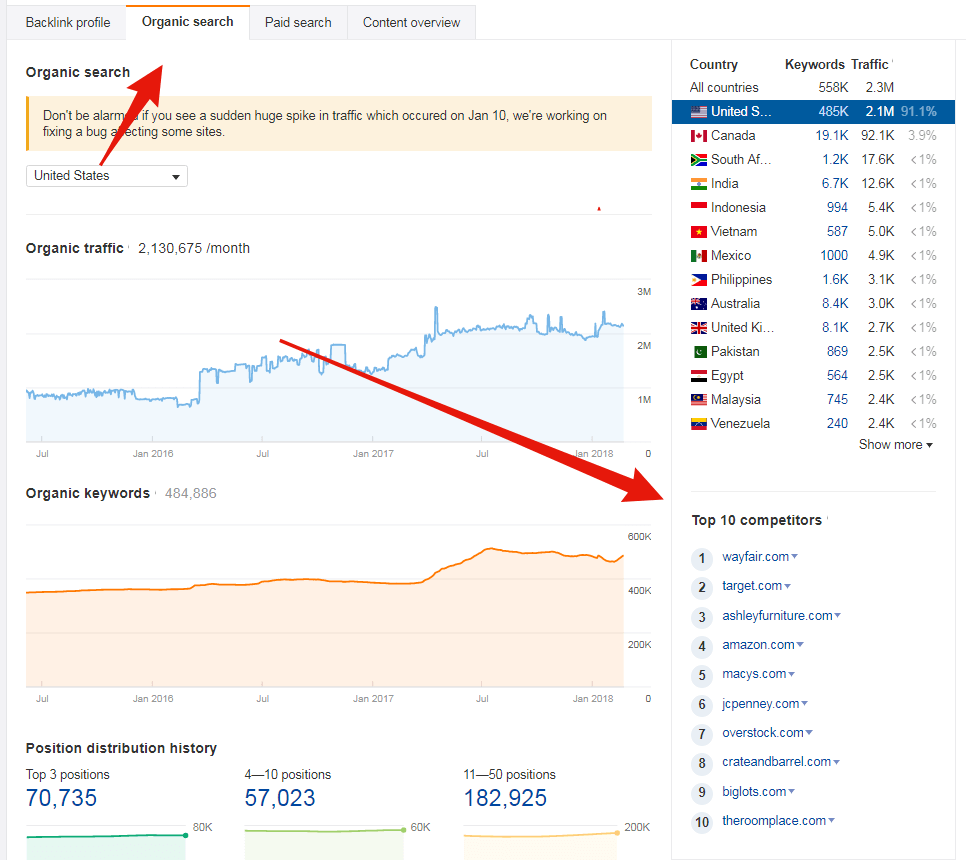
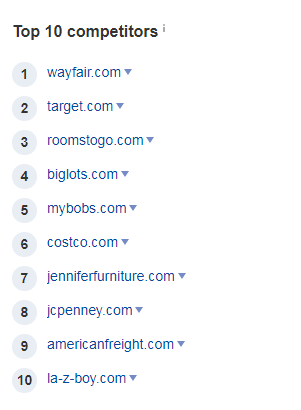
This time we will use one of the biggest online furniture stores in the USA – Wayfair.com – as a direct competitor. We can move on to Organic search -> Organic keywords. Here you can also see the number of keywords the site is ranking for.
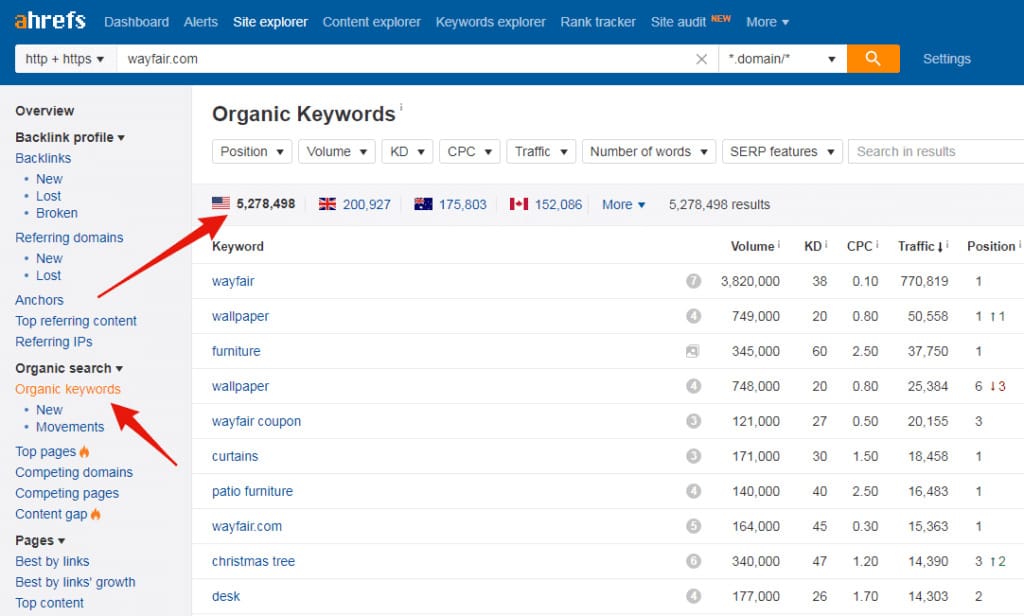
That’s pretty much it for this point, really.
You can export their most popular keywords for this site, put them in the sheet, and start looking for another website.
One question you might have here is how many keywords should I export? It depends on the competitors you pick and their keywords. Their top 100 keywords might refer mostly to their brand, and the next 10,000 might have the real gold; it all depends. You just need to look carefully.
Now you have an unlimited source of different keyword ideas. When you have your combined sheet, remember to delete all the duplicates.
Side note: If you don’t build your keyword directory from scratch and your site is already ranking for some key phrases – there is also a feature called Content Gap. You can list some of your competitors and your domain, and it will list keywords that your competitors are ranking for and your site isn’t. It can be useful during this step.
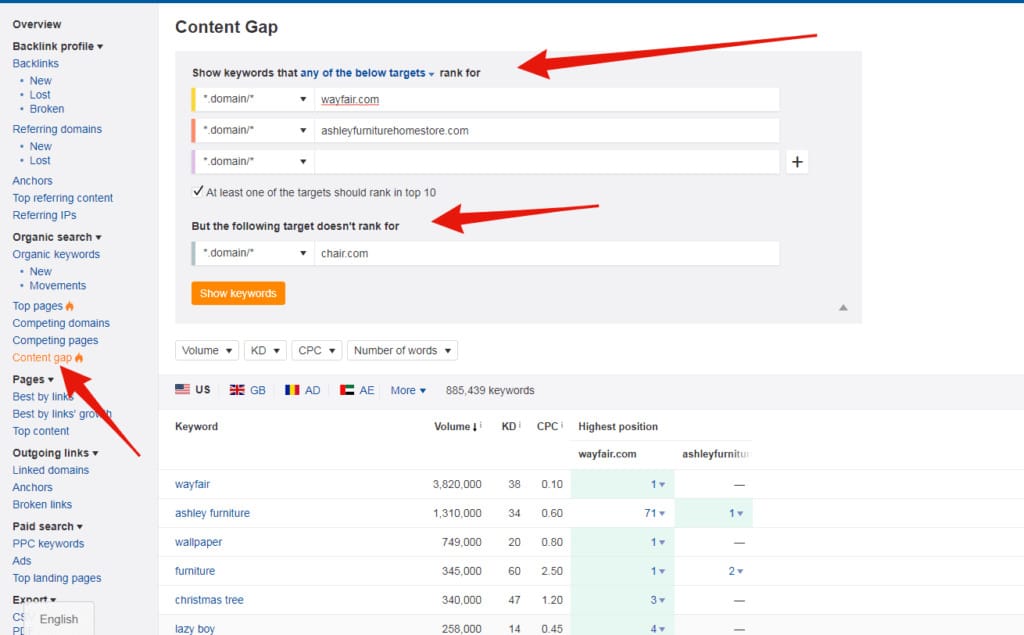
Categorizing
The second step is a little more interesting. When you have your 2,000/5,000/10,000/whatever number of keywords in your sheet, you can start to group them into specific categories, which will later refer to particular landing pages on your site. To create these categories, you need to find general keywords that a particular category can be focused around. These keywords are known as – fittingly – focus keywords. With these, you’ll be able to create your new site structure or improve the present one.
You shouldn’t need any specific tool to find your focus keywords. When you collect keywords from your competitors, you’ll go through your keyword sheet many times, and you’ll be able to see some patterns from which you can create your focus keywords. And because you will do it on your own, your new site structure can consist of landing pages that are even more valuable than your competitor’s pages.

When you’re done with your categories, the next step in grouping your keywords is to sort them into head and long-tail groups. Basic head keywords like “coffee table” or “picture frames” are great for ranking your landing pages. But between long-tail keywords, you might find valuable phrases that qualify for having their own pages focused around them, like blog articles or guides, e.g., “how to decorate a living room” or “how to get rid of old furniture.”
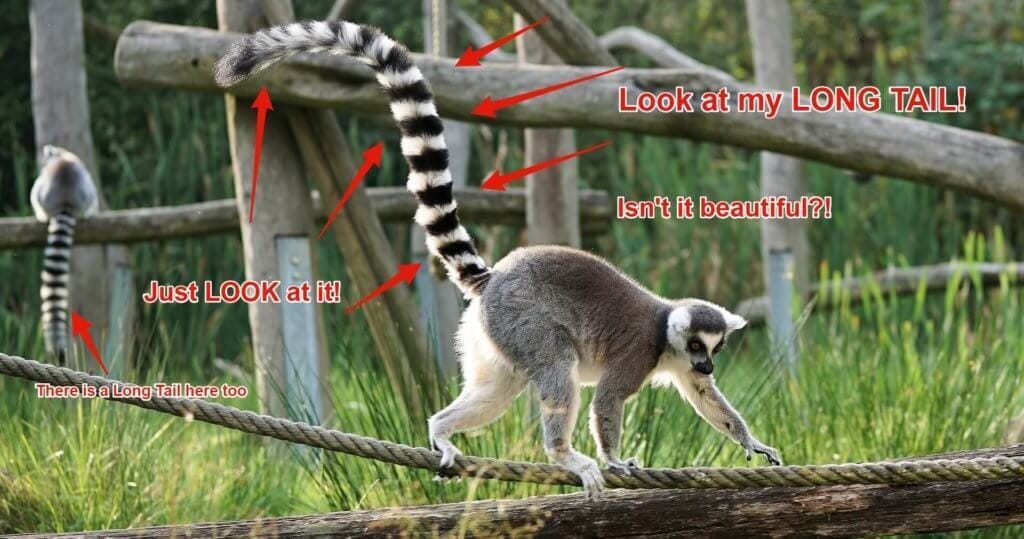
Another important aspect is to not optimize the content around the same keyword on more than one page. It might create content cannibalization, and your pages will compete with each other for traffic. Keywords for every page should be unique.
During the categorization process, you might realize that with your new categories, landing pages, blog, and so on, you can create a new Information Architecture for your site. Basically, the point of proper Information Architecture is to help organize your site’s structure – users, as well as bots, can reach the most valuable pages with little to no effort. With your new ideas for pages, creating a well-optimized structure might be easier.
Also, this is when you may take advantage of information architecture services.
Now you have a nice set of grouped keywords for your landing pages and also a set of topics for your site’s blog. What else can you ask for?
Well, more keywords!
Keyword Explorer
That’s why we will use this magical thing known as Keyword Explorer. The main purpose of this tool is to suggest related keywords to the ones we type into it.
Most keyword explorers – like, for example, neilpatel.com/ubersuggest – take their keyword ideas from scraping Google Keyword Planner or Google suggestions. These methods are decent but not great – the amount of keywords you will get is unimpressive. For example, at Ubersuggest, you will get less than 1,000 keyword suggestions for “chair.”
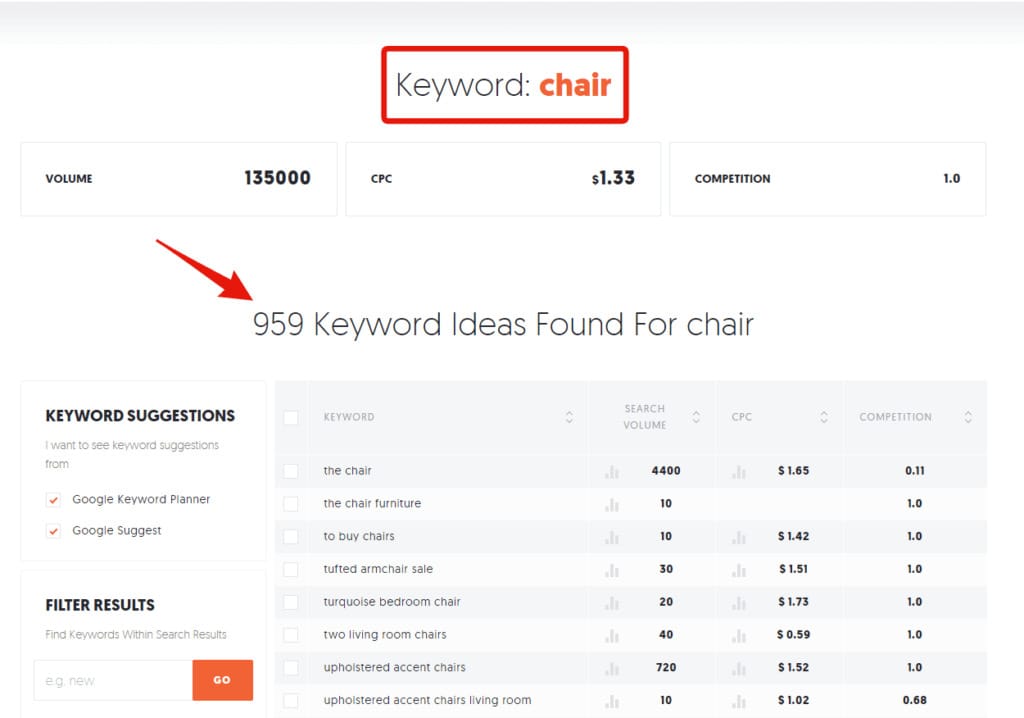
Other more advanced tools, like Moz’s Keyword Explorer or Ahrefs, use their own database of keywords. Thanks to this method, you can get many more keyword ideas. For instance, Ahrefs provides over a million suggestions for “chair.”
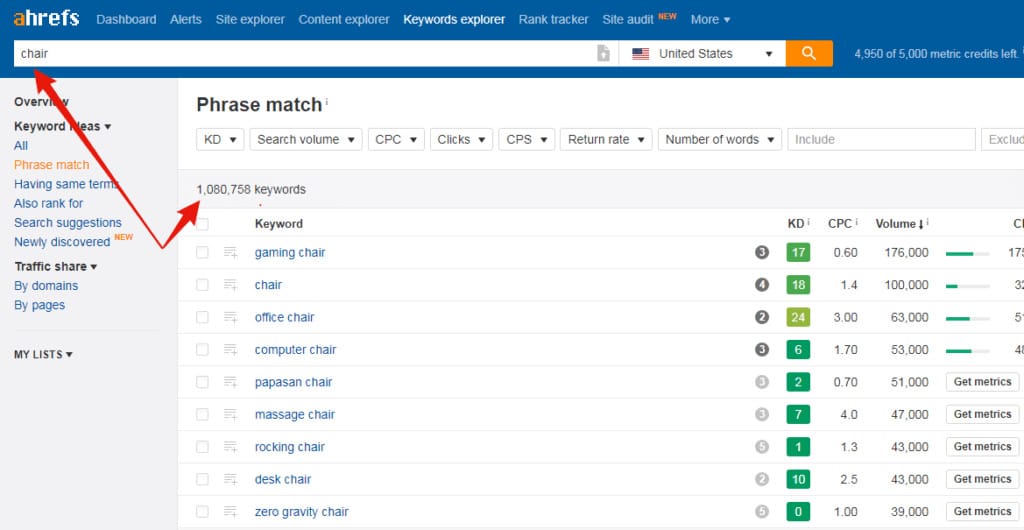
Ahrefs also offers various options that let you get different types of keyword ideas.
Let’s take an original phrase like “massage chair”:
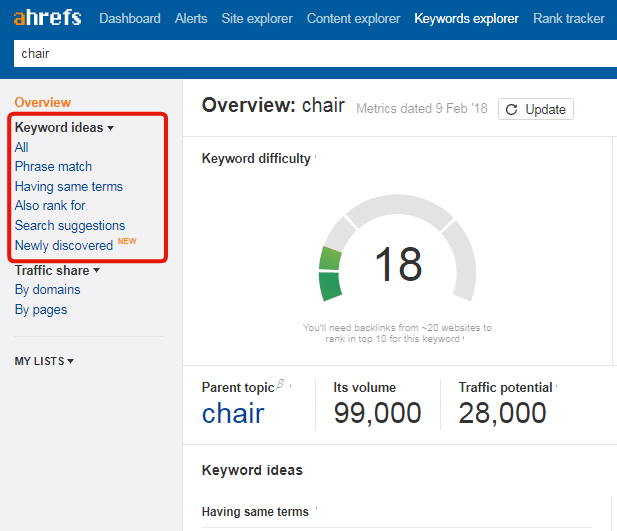
Here’s what you can see in the Overview:
Phrase Match – These are suggestions that contain the exact phrase you put as a focus keyword; for “massage chair,” it would be phrases like “best massage chair” or “shiatsu massage chair.”
Having the same terms – This is very similar to Phrase Match. Keyword ideas that have any terms that you put in your focus phrase in any order. When we use “massage chair,” we get phrases like “massage therapy chair” or “why is chair massage important in the workplace.”
Also, rank for – Here Ahrefs takes the top 10 pages that are ranking for your focus keyword and lists all the other keywords that these pages are ranking for. For “massage chair,” we’ve got phrases generally related to massage or other massage machines.
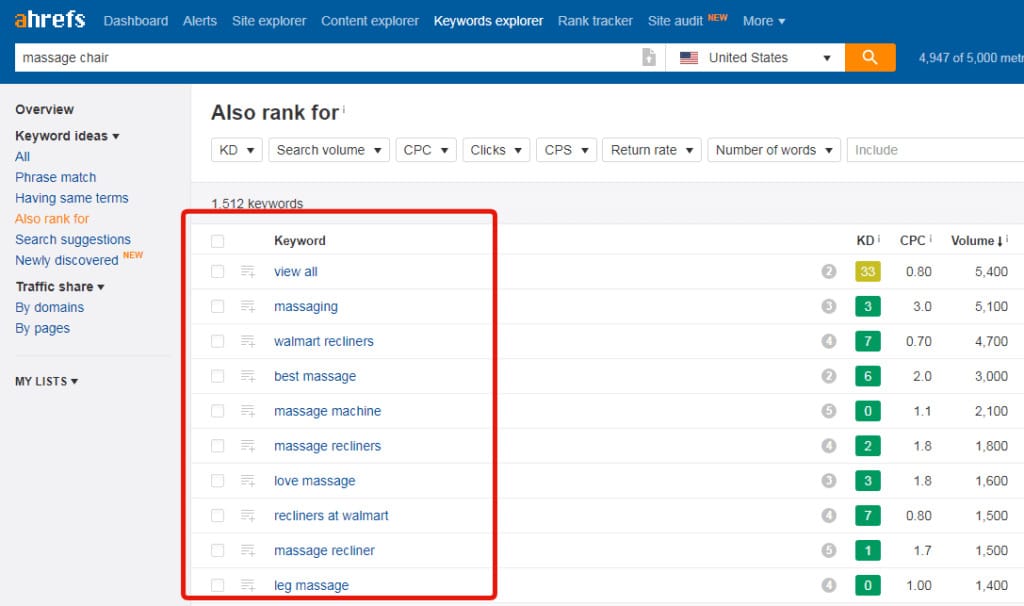
Search suggestions – Here, you’ll find the list of keyword ideas that are suggested via Google’s autocomplete for your focus keyword. The results are similar to Phrase Match.
Newly discovered – These are keywords from Phrase Match that were recently added to Ahrefs’ database.
Here is one way I like to use these options: open Keyword Explorer in one tab and in another tab go to the Site explorer of one of your competitors to get their Top Pages (pages that have the biggest estimated traffic) and look at their top keywords for these pages.
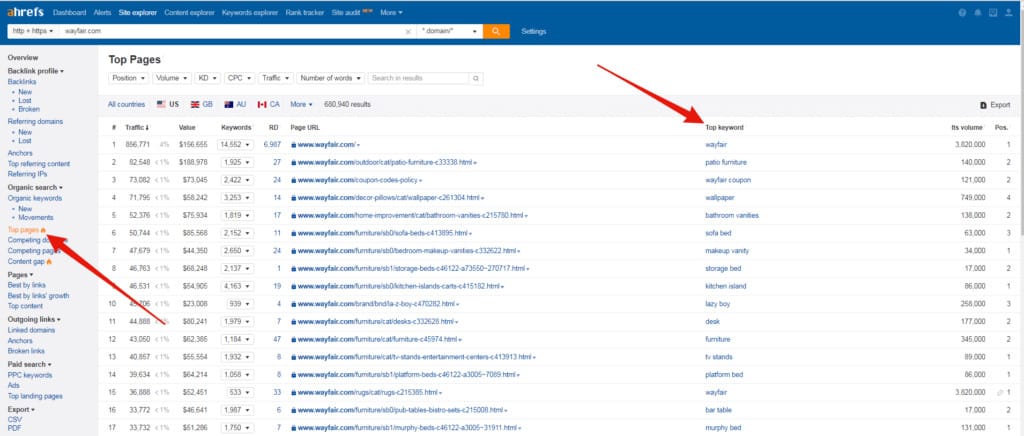
You can put these top keywords into Keyword Explorer and then expand your keyword directory with keywords that your competition might not rank for and outdo them by using the options Phrase Match and Having same terms. You can also use the Also rank for the option to get keywords from other competing pages (not just your competitors) that are ranking for this keyword to expand your directory even further.
With all of this, you can play around with Ahrefs’ Keyword Explorer and its features, put in the focus keywords you found during the categorizing process, and expand your keyword directory as much as you want.
Filtering, Filtering & Filtering
If you follow through with everything I’ve written above, you should have an impressive directory of keywords for your site.
Well, at first glance, at least.
Remember what we said at the beginning? We want valuable keywords in our KR, and valuable doesn’t just mean “popular” keywords, but, more importantly, keywords directly related to your business profile.
And here we are – at the most important part of keyword research: Filtering.

What do you want to get rid of?
The answer is “things that just don’t fit.” For example, as we said before, you don’t want keywords that are unrelated to your business profile, duplicates, keywords with typos, or keywords that are just straight up related to porn, and yes, you will literally find them all in every attempt at KR.
Let’s go back to our furniture store and try to get a list of key phrases containing our favorite word, “chair.”
Here is part of the Top 50 keyword suggestions from Ahrefs for the word “chair” that might end up in our keyword research:
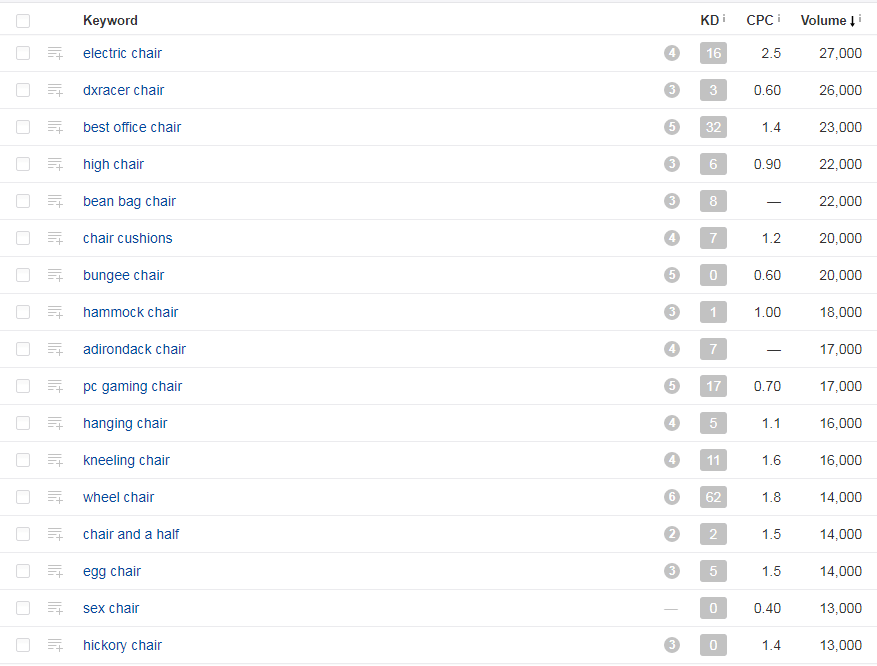
Now let me help you:
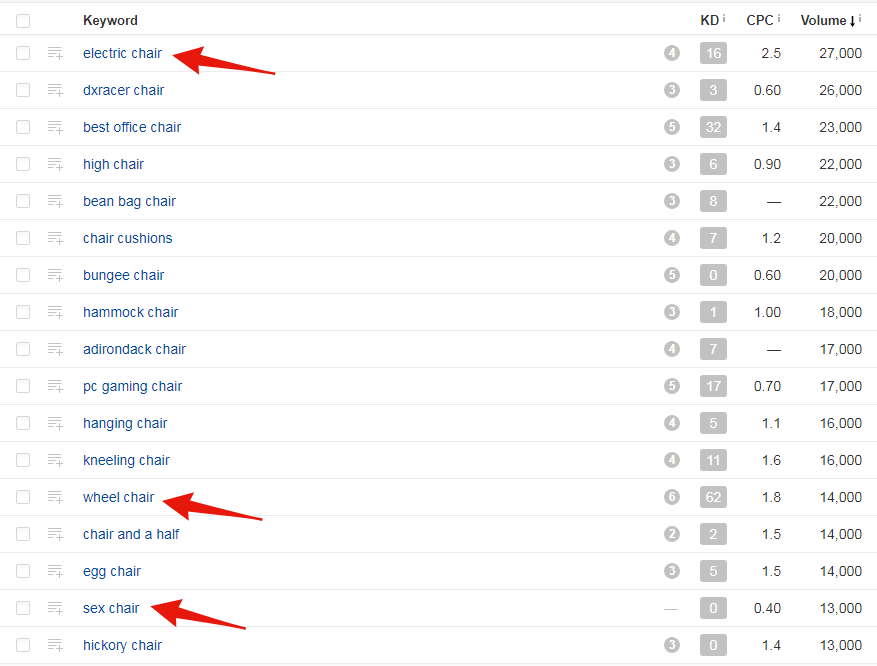
As you can see above, there are a couple of phrases that are unrelated to furniture. So naturally, we don’t want any of them in our KR for our furniture store.
The bigger your directory is, the more you’ll have to filter out. Again, you can do it during the previous steps, when you are collecting keywords from your competitors or when you are grouping them into categories, or you can focus on this part at the end like we just did here.
One thing to remember: you need to filter your keyword directory many times, and when I say many times, I mean MANY times. You want your keyword research to be as clean and valuable as possible.
Conclusion
Aaaand we’re done.
With your KR completed, this should help you achieve satisfying positions in the search results. You’ll be able to create valuable content on your website, and this is when the work begins. You will need to create a page for every keyword or group of keywords you want to rank for, either as a product page, an article, a guide, or whatever kind of page your site is focusing on. That might take some time, so have fun.
And just to be clear, I wasn’t paid by Ahrefs to write this article and say these nice words about them. I just really enjoy their tools.




